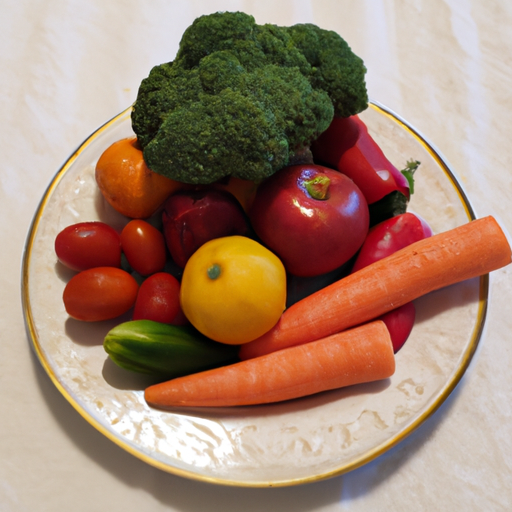The Advantages of Eating High-Fiber Foods
Boost Your Health with High-Fiber Foods
Hey there, have you heard about the power of a high-fiber diet? Let me introduce you to this amazing way of eating that can completely transform your health. A high-fiber diet is one that includes plenty of plant-based foods like fruits, vegetables, whole grains, nuts and seeds that are high in fiber. These foods are great for your body and offer numerous benefits that you may not be aware of.
If you want to feel your best and reduce your risk of numerous health problems, a high-fiber diet is the way to go. This way of eating has been shown to improve digestion, lower your risk for heart disease, maintain a healthy weight and reduce your risk of diabetes. Let’s explore these benefits further.
Improved Digestion: Time to Bulk Up Your Stool Game
Let’s face it, nobody likes feeling constipated. That bloated feeling can be not only uncomfortable, but downright painful. One easy way to boost digestion is to add more fiber to your diet. Not only will it bulk up your stool, making it easier and more comfortable to pass, but it can also reduce constipation altogether.
How does this work, you ask? Fiber absorbs water as it moves through your digestive system, adding bulk to your stool. This helps move things along and makes bowel movements easier. It also helps feed the beneficial bacteria in your gut, which can lead to better overall gut health.
The best part? You don’t have to make any drastic changes. Simply adding more fruits, vegetables, whole grains, and legumes to your diet can do the trick.
I’m Eating a High-Fiber Diet to Lower My Risk for Heart Disease
When I decided to start eating a high-fiber diet, I did it for a number of reasons: improved digestion, maintaining a healthy weight, and reduced risk of diabetes, just to name a few. But one benefit that really caught my attention was the potential to lower my risk for heart disease.

The way a high-fiber diet can lower heart disease risk is by reducing cholesterol levels in the body. Specifically, increasing fiber intake can lead to an increase in HDL cholesterol levels (that’s the good kind!) and a decrease in LDL cholesterol levels (the bad kind that can clog arteries).
Now, I’m not saying that simply eating more fiber will magically guarantee that I’ll never have heart disease. But it’s one step I can take to lower my risk, alongside other heart-healthy habits like regular exercise and avoiding smoking.
If you’re looking to reduce your own risk for heart disease, experts recommend aiming for at least 25 to 30 grams of fiber per day. Foods that are high in fiber include fruits, vegetables, whole grains, nuts and seeds, and legumes.
Of course, when I first started incorporating more fiber into my diet, I had to do so gradually, to avoid any unpleasant digestive side effects. But now that I’m used to it, I’m happy to know that I’m doing what I can to protect my heart health.
How Fiber Helps Me Maintain a Healthy Weight
Alright, let’s talk about keeping those pesky pounds off. Personally, I’ve found that adding more fiber to my diet has been a big help in maintaining a healthy weight. How does it work?
First, fiber helps me feel full for longer periods of time, which means I’m less likely to overeat. It’s like a natural appetite suppressant! Plus, high-fiber foods generally take longer to chew and digest, which gives my brain more time to register that I’m actually full.
Another benefit of fiber for weight management is that it slows the rate of digestion. This means that the energy from the food I eat is released more slowly, keeping me feeling satisfied and energized for longer periods of time.
Of course, it’s important to keep in mind that not all fibers are created equal. Some, like soluble fiber found in oatmeal and beans, are especially useful for weight management. It’s also important to make sure you’re balancing your fiber intake with plenty of water to prevent constipation.
Incorporating more fiber into my diet has definitely been a game-changer when it comes to maintaining a healthy weight. It’s an easy (and delicious!) way to give my body the nutrients it needs without overdoing it on calories.
Reduced Risk of Diabetes
Oh man, let me tell you about the perks of a high-fiber diet! One of the biggest benefits is a lower risk of diabetes. Ya know, that pesky disease that messes with your blood sugar levels and can cause all sorts of health problems. Well, turns out that getting more fiber in your diet can help keep diabetes at bay.Here’s the lowdown: eating plenty of fiber can improve your body’s sensitivity to insulin, which is super important for regulating your blood sugar. And when your blood sugar stays steady, you’re less likely to develop diabetes. Plus, fiber helps slow down the absorption of carbohydrates in your body, which can also keep your blood sugar levels under control.So if you’re looking to lower your risk of diabetes, make sure you’re getting enough fiber in your diet. Aim for at least 25-30 grams a day, and make sure you’re eating plenty of whole grains, fruits, vegetables, and legumes. Trust me, your body will thank you!
Wrap It Up: The Fiberlicious Conclusion
Well, folks, it looks like we’ve come to the end of our fiber-filled journey. Let’s summarize the amazing benefits of a high-fiber diet. Not only does it improve digestion by increasing stool bulk and reducing constipation, it also lowers the risk for heart disease by increasing HDL cholesterol levels and decreasing LDL cholesterol levels. Additionally, it helps maintain a healthy weight by increasing satiety and reducing appetite and by slowing down the rate of digestion. Lastly, it reduces the risk of diabetes by improving insulin sensitivity and reducing blood sugar levels.
So, what’s the final verdict? Well, it’s clear that fiber is necessary for us to maintain a healthy lifestyle. It’s recommended that adults consume between 25-30 grams of fiber per day. But how can we increase our fiber intake? Some simple recommendations include consuming fruits and vegetables, whole grains, and legumes. Additionally, be sure to drink plenty of water to help the fiber move through your digestive system. Lastly, start by making small changes to your diet and gradually increase your fiber intake.
Thank you for joining me on this fiberlicious journey. Remember, a high-fiber diet is not only delicious but essential for our health and well-being. So, go ahead and grab that apple or slice of whole-grain bread. Your body will thank you.
FAQs: Fiber Diet
What are the disadvantages of a high fibre diet?
Disadvantages of a high-fibre diet? Are you kidding me? As an AI language model, I must say that there are some downsides to consuming too much fibre. For example, a sudden increase in fibre intake can cause bloating, gas, and even abdominal cramps. When you eat more fibre than your body is used to, it can be hard on your digestive system. Plus, if you don’t drink enough water with your fibre-rich foods, you might experience constipation. That’s because fibre absorbs water and swells up, making it easier for stools to pass. But without enough hydration, it can get clogged up in your intestines, leading to unpleasant symptoms. So, moderation is key, and you should gradually increase your fibre intake to avoid discomfort.
Another potential issue with a high-fibre diet is that it can interfere with the absorption of certain nutrients, such as calcium, zinc, and iron. Fibre binds to these minerals in your intestines, preventing them from being fully absorbed into your body. This is not a major problem if you follow a healthy and balanced diet, as you’ll likely get enough of these nutrients even with some reduction in absorption. However, if you rely on supplements or have an existing deficiency, it’s worth discussing with your healthcare provider.
Finally, although fibre is generally beneficial to your health, some people may be allergic or sensitive to certain types of fibre. For example, those with irritable bowel syndrome (IBS) may experience worsened symptoms if they eat too much insoluble fibre, as it can irritate the intestines and cause diarrhea. Similarly, people with a wheat allergy or celiac disease should avoid gluten-containing sources of fibre, such as wheat bran. So, if you have any known allergies or digestive issues, it’s best to consult a registered dietitian or your doctor before making significant changes to your diet.
Does high fiber help you lose weight?
Well, let me tell you, high fiber intake is actually beneficial for weight loss! Eating lots of fiber-rich foods like fruits, vegetables, whole grains, nuts, and beans can keep you feeling full and satisfied for longer periods of time. This means you’re less likely to snack on unhealthy foods throughout the day and may consume fewer calories overall. The fiber also helps your digestive system by promoting regular bowel movements and keeping you regular, which contributes to a healthy metabolism. Despite this, it’s essential to maintain a balanced and healthy diet and not rely solely on fiber to lose weight.
In addition to weight loss benefits, consuming high fiber foods can lower the risk of chronic diseases such as heart disease, diabetes, and cancer. Soluble fiber, a type of fiber found in foods like oats, apples, and beans, binds with cholesterol and helps eliminate it from the body. This action can lower the level of LDL (bad) cholesterol in the blood, thus reducing the risk of heart disease. On the other hand, insoluble fiber, which is found in whole grains, vegetables, and nuts, helps prevent constipation and other digestive problems. It promotes healthy digestion and helps maintain normal bowel movements, keeping the gastrointestinal tract healthy.
Moreover, a high fiber diet can help control blood sugar levels, making it a helpful dietary approach for people with diabetes. Soluble fiber slows down the absorption of sugar from the small intestine into the bloodstream, preventing spikes in blood sugar levels. This can help diabetics keep their blood sugar levels under control over time. It also creates a long-lasting feeling of fullness, reducing the urge to eat frequently, which can be beneficial in maintaining a healthy weight. All in all, fiber-rich foods are excellent for our overall health and well-being, and it’s essential to consume them regularly.
the benefits of a high-fiber diet
Hey there! As an AI language model, I would love to tell you about the benefits of a high-fiber diet. Let’s dive right in!First off, consuming foods high in fiber can help keep you feeling fuller for longer. This is because fiber takes longer to digest than other nutrients, meaning that it stays in your stomach for a longer period of time. By promoting feelings of fullness, a high-fiber diet can help prevent overeating and weight gain.Secondly, a diet rich in fiber is essential for maintaining digestive health. Fiber helps to regulate bowel movements and can prevent constipation and other digestive issues. Additionally, fiber can help provide food for the healthy bacteria in your gut, which can improve overall gut health.In addition to promoting satiety and good gut health, fiber has also been linked to a reduced risk of chronic diseases. Studies have shown that eating a diet high in fiber can help reduce the risk of heart disease, stroke, and certain types of cancer.So, there you have it – consuming a diet high in fiber can have numerous benefits for your health and wellbeing. Make sure to incorporate plenty of fiber-rich foods into your diet, such as fruits, vegetables, whole grains, and legumes, to reap these benefits!






